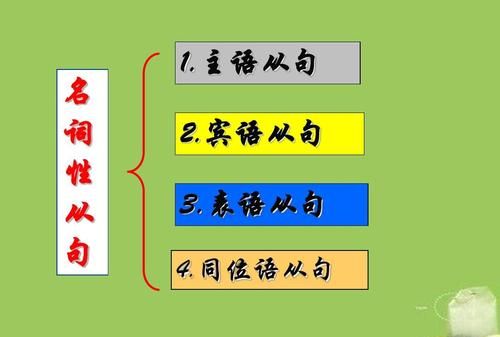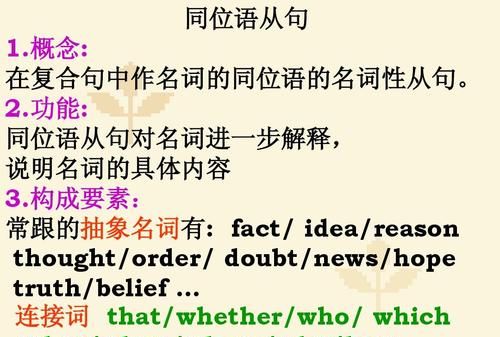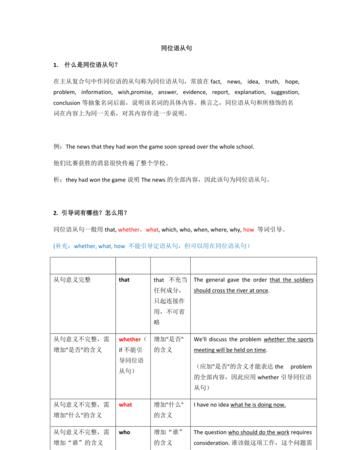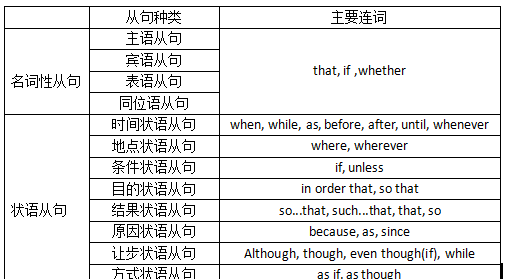本文目录
英语中什么叫同位语从句
网上找的一套讲解, 希望对你有所帮助。
同位语从句讲义及练习一、理解同位语从句的含义,把握同位语从句的实质 在主从复合句中作同位语的从句称为同位语从句。同位语从句一般用that, whether,what, which, who, when, where, why, how 等词引导,常放在fact, news, idea, truth, hope, problem, information, wish,promise, answer, evidence, report, explanation, suggestion, conclusion等抽象名词后面,说明该名词的具体内容。换言之,同位语从句和所修饰的名词在内容上为同一关系,对其内容作进一步说明。例:The news that they had won the game soon spread over the whole school.他们比赛获胜的消息很快传遍了整个学校。析:they had won the game说明The news的全部内容,因此该句为同位语从句。二、正确运用同位语从句的引导词,准确把握同位语从句1.如同位语从句意义完整,应用that引导同位语从句。(即that 不充当任何成分,只起连接作用,不可省略) 例:The general gave the order that the soldiers should cross the river at once.将军下达了战士们立即过河的命令。 析:the soldiers should cross the river at once是the order的全部内容,且意义完整,因此应用that引导同位语从句。2.如同位语从句意义不完整,需增加"是否"的含义,应用whether引导同位语从句。(if不能引导同位语从句) 例:We'll discuss the problem whether the sports meeting will be held on time.我们将讨论运动会是否会如期举行的问题。 析:the sports meeting will be held on time意义不完整,应加"是否"的含义才能表达the problem的全部内容,因此应用whether引导同位语从句。3.如同位语从句意义不完整,需增加"什么时候"、"什么地点"、"什么方式"等含义,应用when, where, how等词引导同位语从句。 例1:I have no idea when he will be back. 析:he will be back意义不完整,应加"什么时候"的含义才能表达idea的全部内容,因此应用when引导同位语从句。 例2:I have no impression how he went home, perhaps by bike.析:he went home意义不完整,应加"如何"的含义才能表达impression的全部内容,因此应用how引导同位语从句。4.当主句的谓语较短,而同位语从句较长时,同位语从句常后置。如:The thought came to him that maybe the enemy had fled the city. 三、把握同位语从句和定语从句的区别,明确同位语从句和相似从句的界限同位语从句和定语从句相似,都放在某一名词或代词后面,但同位语从句不同于定语从句。同位语从句对名词加以补充说明,是名词全部内容的体现,且名词和同位语从句的引导词均不在从句中作成分;定语从句说明先行词的性质与特征,与先行词是修饰与被修饰的关系,且名词和定语从句的引导词均在从句中作成分。区分时可以在先行词与从句之间加一个系动词be,使之构成一个新句子,如果句子通顺且符合逻辑,则为同位语从句,反之,则为定语从句。如:The report that he was going to resign was false.因为the report was that he was going to resign 句意通顺,所以,that he was going to resign 是同位语从句。例1:1)Information has been put forward ____ more middle school graduates will be admitted into universities. A. while B. that C. when D. as 析:答案为B。more middle school graduates will be admitted into universities是Information的内容,且Information不在从句中作成分,所以该句为同位语从句。应将该句区别于:2)It is said that more middle school graduates will be admitted into universities,this is the information ____ has been put forward. A. what B. that C. when D. as 析:答案为B。that has been put forward为information的修饰性定语,且information在从句中作主语,所以该句为定语从句。例2:She heard a terrible noise,____ brought her heart into her mouth.(MET91) A. it B. which C. this D. that 析:答案为B。分析语境含义、句子结构和句子成分可知,该句为非限制性定语从句,先行词为a terrible noise,且它在从句中作主语。应将该句区别于: I can't stand the terrible noise ____ she is crying loudly. A. it B. which C. this D. that 析:答案为D。she is crying loudly是the terrible noise的内容,且the terrible noise不在从句中作成分,所以该句为同位语从句。巩固性练习:1. The fact ____ she works hard is well known to us all. A. that B. what C. why D. which2. The fact ____ he was successful proves his ability. A. hat B. what C. which D. why3. The news ____ he was kidnapped surprised us greatly. A. what B. that C. why D. when4. His suggestion ____ the meeting be delayed was turned down. A. which B. that C./ D. it5. I have no idea ____ he will start. A. when B. that C. what D./6. I've come from the government with a message ____ the meeting won't be held tomorrow. A. if B. that C. whether D. which7. The thought ____ he might fail in the exam worried him. A. when B. which C. what D. that8. The order ____ the prisoner be set free arrived too late. A. which B. whether C. that D. what9. The nurses are trying their best to reduce the patient's fear ____ he would die of the disease. A. that B. as C. of which D. which10. He often asked me the question ____ the work was worth doing. A. whether B. where C. that D. when Keys: 1-5 AABBA 6-10 BDCAA同位语从句和定语从句的三点区别同位语从句和定语从句很相似,但还是有区别的,区别主要在以下三方面:1. 从词类上区别同位语从句前面的名词只能是idea,fact,news,hope,belief,suggestion,proposal,word,thought,doubt,truth,possibility,promise,order等有一定内涵的名词?而定语从句的先行词可以是名词?代词?主句的一部分或是整个主句?如:The possibility that the majority of the labour force will work at home is often discussed. (同位语从句)We are not looking into the question whether he is worth trusting.(同位语从句)Word came that he had been abroad. (同位语从句)Our team has won the game, which made us very happy.我们的队赢了,这让我们很高兴?(定语从句)The doctor whom you are looking for is in the room.你找的那位医生在房间里面?(定语从句)His mother did all she could to help him with his study.他妈妈尽她的最大努力帮助他的学习?(定语从句,代词all作先行词?)2. 从性质上区别定语从句是从句对其先行词的修饰或限制,属于形容词性从句的范畴;而同位语从句是从句对前面抽象名词的进一步的说明和解释,属于名词性从句的范畴。如:The news that our team has won the game was true. 我们队赢了那场比赛的消息是真的?(同位语从句,补充说明news到底是一个什么消息?)The news that he told me yesterday was true. 昨天他告诉我的那个消息是真的?(定语从句,news在从句中作told的宾语?)I made a promise that if anyone set me free I would make him very rich. 我许诺如果谁让我自由,我就让他非常富有?(同位语从句,补充说明promise到底是一个什么诺言?)The mother made a promise that pleased all her children. 妈妈做出了一个令她的孩子们高兴的许诺?(定语从句,promise在从句中作pleased的主语?)3. 从引导词及其在句子中的成分上区别有些引导词如how, whether, what可以引导同位语从句,但不能引导定语从句?如:That question whether we need it has not been considered. 我们是否需要它这个问题还没有考虑?(同位语从句)I have no idea what has happened to him. 我不知道他发生了什么事?(同位语从句)引导词that引导定语从句时,在从句中一般作主语或宾语(指物时还可以用which代替),并且作宾语时常常省略?that在同位语从句中仅起连接作用,不充当任何成分,并且不能省略,也不能用which来代替?如:The order that we should send a few people to help the other groups was received yesterday. 我们应派几个人去帮别的几个小组的命令昨天收到了?(同位语从句,是对order的具体解释,that虽不作成分,但不能省略?)The order that we received yesterday was that we should send a few people to help the other groups. 我们昨天收到的命令是我们应该派几个人去帮助别的几个小组?(定语从句,是名词order的修饰语,that在从句中作received的宾语,可以省略?)

同位语从句的先行词一般是什么
同位语部分是个句子,就是同位语从句,这种用法比较"固定",把关键的几个词背下来.
下面这个材料供参考.
===========================
一、在复合句中用作同位语的从句叫同位语从句。它一般跟在某些名词后面,用以说明该名词表示的具体内容。如:
I heard the news that our team had won.我听到了我们队获胜的消息。
I had no idea that you were here.我不知道你在这里。
二、可以跟同位语从句的名词通常有news,idea,fact,promise,question,doubt,thought,hope,message,suggestion,words(消息),possibility等。如:
I’ve come from Mr wang with a message that he won’t be able to see you this afternoon. 我从王先生那里来,他让我告诉你他今天下午不能来看你了。
三、英语中引导同位语从句的词通有连词 that,whether,连接副词 how,when,where等。(注:if,which 不能引导同位语从句。)如:
l have no idea when he will be back.我不知道他什么时候回来。
He must answer the question whether he agrees to it or not.
他必须回答他是否同意这样一个问题。
四、有时同位语从句可以不紧跟在说明的名词后面,而被别的词隔开。 如:
Several years later,word came that Napoleon himself was coming to inspect them.
几年以后,有消息传来说拿破仑要亲自视 察他们。
The thought came to him that maybe the enemy had fled the city.
他突然想起可能敌人已经逃出城了。
五、同位语从句与定语从句的区别。
1、同位语从句与前面的名词是同位关系,即说明它前面名词的内容;而定语从句与前面的名词是修饰与被修饰关系,即限定它前面的名词范围,或补充一些情况。如:
The news that l have passed the exam is true.我通过了考试这一消息是真的。
(同位语从句,即从句所表达的意思就是前面名词的内容。)
The news that he told me just now is true.他刚才告诉我的消息是真的。
(定语从句,从句对前面名词起修饰限制作用,即“他告诉我的”那个消息,而不是别的消息。)
2、关系词在句中是否做成分 。如:
The idea that computers can recognize human voices surprises many people.
计算机能够识别人的声音的想法使许多人感到惊奇。(that在从句中不充当任何成份。)
The idea that he gave surprises many people.他提出的观点令许多人感到吃惊。
(that在从句中作gave的宾语。)
3、从句是否有疑问的意义。如:
eg.Do you remember the day when i told you that i loved you?(when引导的从句不表示疑问,所以这是一个定语从句。)
eg.I have asked the question why it was true just now.(why引导的从句表示疑问,所以这是一个同位语从句。)
一个名词(或其它形式)对另一个名词或代词进行修饰,限定或说明,这个名词(或其它形
式)就是同位语。同位语与被它限定的词的格要一致,并常常紧挨在一起。
六、典型例题
例1:I have no idea when he will be back.
析:he will be back意义不完整,应加“什么时候”的含义才能表达idea的全部内容,因此应用when引导同位语从句。
例2:I have no impression how he went home,perhaps by bike.
析:he went home意义不完整,应加“如何”的含义才能表达impression的全部内容,因此应用how引导同位语从句。
例3:Information has been put forward ____ more middle school graduates will be admitted into universities.(NMET2001上海)
A.while B.that C.when D.as
析:答案为B.more middle school graduates will be admitted into universities是Information的内容,且Information不在从句中作成分,所以该句为同位语从句。应将该句区别于:
It is said that more middle school graduates will be admitted into universities,this is the information ____ has been put forward.
A.what B.that C.when D.as
析:答案为B.that has been put forward为information的修饰性定语,且information在从句中作主语,所以该句为定语从句。
例4:She heard a terrible noise,____ brought her heart into her mouth.(MET91)
A.it B.which C.this D.that
析:答案为B.分析语境含义、句子结构和句子成分可知,该句为非限制性定语从句,先行词为a terrible noise,且它在从句中作主语。应将该句区别于:
I can’t stand the terrible noise ____ she is crying loudly.
A.it B.which C.this D.that
析:答案为D.she is crying loudly是the terrible noise的内容,且the terrible noise不在从句中作成分,所以该句为同位语从句。

何为同位语从句
同位语从句讲解及习题
一、理解同位语从句的含义,把握同位语从句的实质
在主从复合句中作同位语的从句称为同位语从句。同位语从句一般用that, whether,what, which, who, when, where, why, how 等词引导,常放在fact, news, idea, truth, hope, problem, information, wish,promise, answer, evidence, report, explanation, suggestion, conclusion等抽象名词后面,说明该名词的具体内容。换言之,同位语从句和所修饰的名词在内容上为同一关系,对其内容作进一步说明。
例:The news that they had won the game soon spread over the whole school.他们比赛获胜的消息很快传遍了整个学校。
析:they had won the game说明The news的全部内容,因此该句为同位语从句。
二、正确运用同位语从句的引导词,准确把握同位语从句
1.如同位语从句意义完整,应用that引导同位语从句。(即that 不充当任何成分,只起连接作用,不可省略)
例:The general gave the order that the soldiers should cross the river at once.将军下达了战士们立即过河的命令。
析:the soldiers should cross the river at once是the order的全部内容,且意义完整,因此应用that引导同位语从句。
2.如同位语从句意义不完整,需增加"是否"的含义,应用whether引导同位语从句。(if不能引导同位语从句)
例:We'll discuss the problem whether the sports meeting will be held on time.我们将讨论运动会是否会如期举行的问题。
析:the sports meeting will be held on time意义不完整,应加"是否"的含义才能表达the problem的全部内容,因此应用whether引导同位语从句。
3.如同位语从句意义不完整,需增加"什么时候"、"什么地点"、"什么方式"等含义,应用when, where, how等词引导同位语从句。
例1:I have no idea when he will be back.
析:he will be back意义不完整,应加"什么时候"的含义才能表达idea的全部内容,因此应用when引导同位语从句。
例2:I have no impression how he went home, perhaps by bike.
析:he went home意义不完整,应加"如何"的含义才能表达impression的全部内容,因此应用how引导同位语从句。
4.当主句的谓语较短,而同位语从句较长时,同位语从句常后置。
如:The thought came to him that maybe the enemy had fled the city.
三、把握同位语从句和定语从句的区别,明确同位语从句和相似从句的界限
同位语从句和定语从句相似,都放在某一名词或代词后面,但同位语从句不同于定语从句。同位语从句对名词加以补充说明,是名词全部内容的体现,且名词和同位语从句的引导词均不在从句中作成分;定语从句说明先行词的性质与特征,与先行词是修饰与被修饰的关系,且名词和定语从句的引导词均在从句中作成分。
区分时可以在先行词与与从句之间加一个系动词be,使之构成一个新句子,如果句子通顺且符合逻辑,则为同位语从句,反之,则为定语从句。
如:The report that he was going to resign was false.
因为the report was that he was going to resign 句意通顺,所以,that he was going to resign 是同位语从句。
例1:
1)Information has been put forward ____ more middle school graduates will be admitted into universities.
A. while B. that C. when D. as
析:答案为B。more middle school graduates will be admitted into universities是Information的内容,且Information不在从句中作成分,所以该句为同位语从句。应将该句区别于:
2)It is said that more middle school graduates will be admitted into universities,this is the information ____ has been put forward.
A. what B. that C. when D. as
析:答案为B。that has been put forward为information的修饰性定语,且information在从句中作主语,所以该句为定语从句。
例2:She heard a terrible noise,____ brought her heart into her mouth.(MET91)
A. it B. which C. this D. that
析:答案为B。分析语境含义、句子结构和句子成分可知,该句为非限制性定语从句,先行词为a terrible noise,且它在从句中作主语。应将该句区别于:
I can't stand the terrible noise ____ she is crying loudly.
A. it B. which C. this D. that
析:答案为D。she is crying loudly是the terrible noise的内容,且the terrible noise不在从句中作成分,所以该句为同位语从句。同位语从句巩固性练习:
1. The fact ____ she works hard is well known to us all.
A. that B. what C. why D. which
2. The fact ____ he was successful proves his ability.
A. hat B. what C. which D. why
3. The news ____ he was kidnapped surprised us greatly.
A. what B. that C. why D. when
4. His suggestion ____ the meeting be delayed was turned down.
A. which B. that C./ D. it
5. I have no idea ____ he will start.
A. when B. that C. what D./
6. I've come from the government with a message ____ the meeting won't be held tomorrow.
A. if B. that C. whether D. which
7. The thought ____ he might fail in the exam worried him.
A. when B. which C. what D. that
8. The order ____ the prisoner be set free arrived too late.
A. which B. whether C. that D. what
9. The nurses are trying their best to reduce the patient's fear ____ he would die of the disease.
A. that B. as C. of which D. which
10. He often asked me the question ____ the work was worth doing.
A. whether B. where C. that D. when
Keys: 1-5 AABBA 6-10 BDCAA
同位语从句和定语从句的三点区别
同位语从句和定语从句很相似,但还是有区别的,区别主要在以下三方面:
1. 从词类上区别
同位语从句前面的名词只能是idea,fact,news,hope,belief,suggestion,proposal,word,thought,doubt,truth,possibility,promise,order等有一定内涵的名词?而定语从句的先行词可以是名词?代词?主句的一部分或是整个主句?如:
The possibility that the majority of the labour force will work at home is often discussed. (同位语从句)
We are not looking into the question whether he is worth trusting.
(同位语从句)
Word came that he had been abroad. (同位语从句)
Our team has won the game, which made us very happy.
我们的队赢了,这让我们很高兴?(定语从句)
The doctor whom you are looking for is in the room.
你找的那位医生在房间里面?(定语从句)
His mother did all she could to help him with his study.他妈妈尽她的最大努力帮助他的学习?(定语从句,代词all作先行词?)
2. 从性质上区别
定语从句是从句对其先行词的修饰或限制,属于形容词性从句的范畴;而同位语从句是从句对前面抽象名词的进一步的说明和解释,属于名词性从句的范畴。如:
The news that our team has won the game was true. 我们队赢了那场比赛的消息是真的?(同位语从句,补充说明news到底是一个什么消息?)
The news that he told me yesterday was true. 昨天他告诉我的那个消息是真的?(定语从句,news在从句中作told的宾语?)
I made a promise that if anyone set me free I would make him very rich. 我许诺如果谁让我自由,我就让他非常富有?(同位语从句,补充说明promise到底是一个什么诺言?)
The mother made a promise that pleased all her children. 妈妈做出了一个令她的孩子们高兴的许诺?(定语从句,promise在从句中作pleased的主语?)
3. 从引导词及其在句子中的成分上区别
有些引导词如how, whether, what可以引导同位语从句,但不能引导定语从句?如:
That question whether we need it has not been considered. 我们是否需要它这个问题还没有考虑?(同位语从句)
I have no idea what has happened to him. 我不知道他发生了什么事?(同位语从句)
引导词that引导定语从句时,在从句中一般作主语或宾语(指物时还可以用which代替),并且作宾语时常常省略?that在同位语从句中仅起连接作用,不充当任何成分,并且不能省略,也不能用which来代替?如:
The order that we should send a few people to help the other groups was received yesterday. 我们应派几个人去帮别的几个小组的命令昨天收到了?(同位语从句,是对order的具体解释,that虽不作成分,但不能省略?)
The order that we received yesterday was that we should send a few people to help the other groups. 我们昨天收到的命令是我们应该派几个人去帮助别的几个小组?(定语从句,是名词order的修饰语,that在从句中作received的宾语,可以省略?)

同位语用法及句子示例
同位语概念:一个名词(或其它形式)对另一个名词或代词进行解释或补充说明,这个名词(或其它形式)就是同位语。
例句:The report that he was going to resign was false.(他将辞职的报道是假的。)在此句中,that he was going to resign就是对report内容的说明,因此that引导的就是同位语从句。
The news that he won the match is so exciting.他赢得比赛的消息是如此的振奋人心。
这里that引导的从句做的就是同位语从句。因为that引导的从句就是the news的内容,是对the news 的进一步阐释,所以是同位语从句。
但是很多人很容易将同位语从句和定语从句搞混,请看下面的例句。
He is the man whom/ that I saw yesterday. 他就是我昨天见的那个人。
whom/that引导的从句在此句中引导的就是定语从句。从句和he的关系是从句对he进行限制,哪个he,昨天我见到的那个he.所以,只有汉语意思分析出来的话,就很好判断了。

扩展资料
用法
一个名词(或其它形式)对另一个名词或代词进行修饰,限定或说明,这个名词(或其它形式)就是同位语。
同位语与被它限定的词的格式要一致,并常常紧挨在一起。
同位语从句即重复说明同一个称谓或事件的从句。
名词作同位语
Mr Wang,my child’s teacher,will be visiting us on Tuesday.
王先生,我孩子的老师,星期二要来看我们。
(在这里'my child's teacher'做同位语修饰'Mr Wang')
短语作同位语
I,the oldest girl in the family,always had to care for the other children.
我,作为家里最大的女孩,总是要照料家中的其他孩子。
直接引语作同位语
But now the question comes to their minds,“Did she die young because she was a clone?”
但是现在他们不得不思考这样的问题:“多莉早死是因为它是一只克隆羊吗?”
句子作同位语
The girls were surprised at the fact that ocean ships can sail up the Great lakes.
巨大的海轮可以开到五大湖,让表姐妹俩感到吃惊。
固定用法
同位语部分是个句子,就是同位语从句,这种用法比较"固定"
一、在复合句中用作同位语的从句叫同位语从句。它一般跟在某些名词后面,用以说明该名词表示的具体内容。
I heard the news that our team had won.
我听到了我们队获胜的消息。
二、可以跟同位语从句的名词通常有news,idea,fact,promise,question,doubt,thought,hope,message,suggestion,words(消息),possibility,decision等(一般的“抽象”名词都可用)。
I’ve come from Mr wang with a message that he won’t be able to see you this afternoon.
我从王先生那里来,他让我告诉你他今天下午不能来看你了。
三、英语中引导同位语从句的词通常有连词that,whether,连接代词what,who。连接副词how,when,where等。(注:if不能引导同位语从句。)
He must answer the question whether he agrees with it or not.
他必须回答他是否同意这样一个问题。
四、有时同位语从句可以不紧跟在说明的名词后面,而被别的词隔开。
The thought came to him that maybe the enemy had fled the city.
他突然想起敌人可能已经逃出城了。
参考资料:百度百科 同位语从句
以上就是关于同位语从句的概念及形式及考点 ,英语中什么叫同位语从句的全部内容,以及同位语从句的概念及形式及考点 的相关内容,希望能够帮到您。
